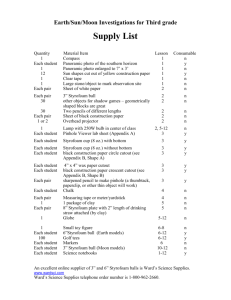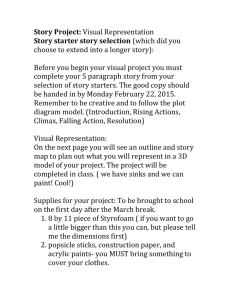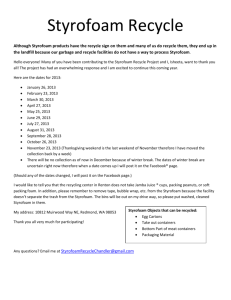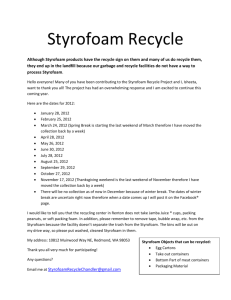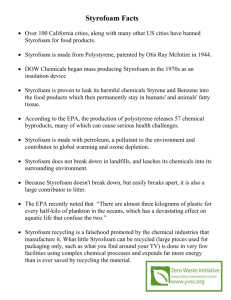SU-Wind_Turbines_Take-Home_Experiment_Write
advertisement
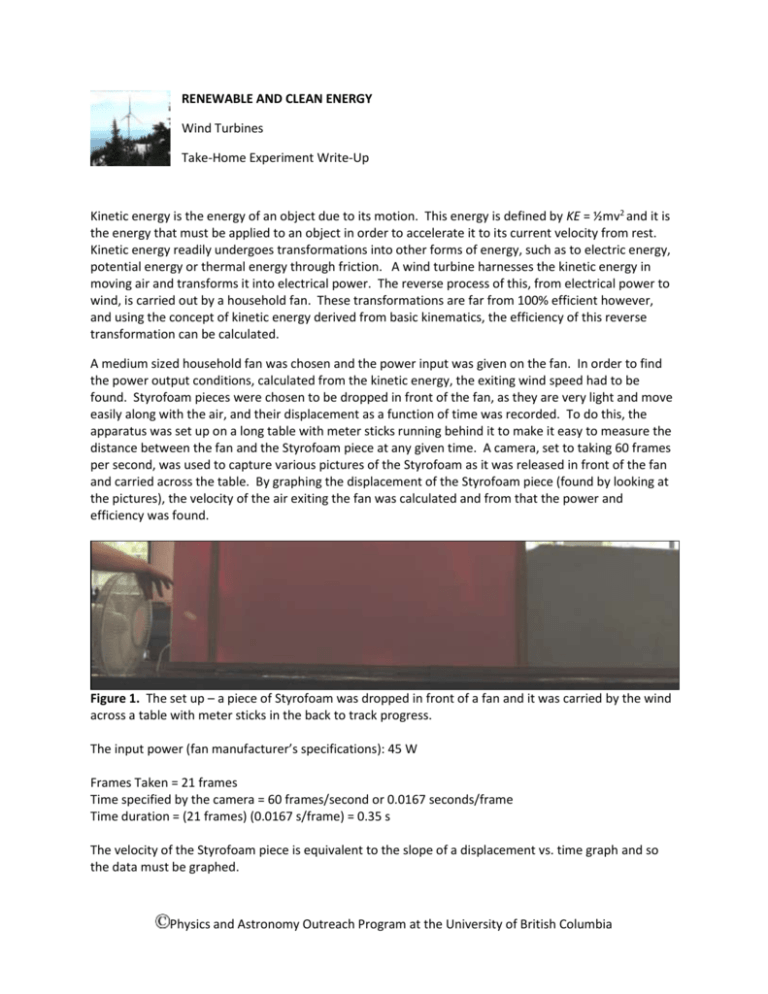
RENEWABLE AND CLEAN ENERGY Wind Turbines Take-Home Experiment Write-Up Kinetic energy is the energy of an object due to its motion. This energy is defined by KE = ½mv2 and it is the energy that must be applied to an object in order to accelerate it to its current velocity from rest. Kinetic energy readily undergoes transformations into other forms of energy, such as to electric energy, potential energy or thermal energy through friction. A wind turbine harnesses the kinetic energy in moving air and transforms it into electrical power. The reverse process of this, from electrical power to wind, is carried out by a household fan. These transformations are far from 100% efficient however, and using the concept of kinetic energy derived from basic kinematics, the efficiency of this reverse transformation can be calculated. A medium sized household fan was chosen and the power input was given on the fan. In order to find the power output conditions, calculated from the kinetic energy, the exiting wind speed had to be found. Styrofoam pieces were chosen to be dropped in front of the fan, as they are very light and move easily along with the air, and their displacement as a function of time was recorded. To do this, the apparatus was set up on a long table with meter sticks running behind it to make it easy to measure the distance between the fan and the Styrofoam piece at any given time. A camera, set to taking 60 frames per second, was used to capture various pictures of the Styrofoam as it was released in front of the fan and carried across the table. By graphing the displacement of the Styrofoam piece (found by looking at the pictures), the velocity of the air exiting the fan was calculated and from that the power and efficiency was found. Figure 1. The set up – a piece of Styrofoam was dropped in front of a fan and it was carried by the wind across a table with meter sticks in the back to track progress. The input power (fan manufacturer’s specifications): 45 W Frames Taken = 21 frames Time specified by the camera = 60 frames/second or 0.0167 seconds/frame Time duration = (21 frames) (0.0167 s/frame) = 0.35 s The velocity of the Styrofoam piece is equivalent to the slope of a displacement vs. time graph and so the data must be graphed. Physics and Astronomy Outreach Program at the University of British Columbia The data was satisfied by the line: distance = (2.732) (time) + 0.099 The velocity of the Styrofoam piece is v = 2.73 m/s. The power = ½ ρ A v3, so the area needs to be found and then the efficiency can be calculated. For the area, take into account the area covered only by the spinning rotor (R). Do not take into account the solid area in the middle of the fan (r) which generates no air flow. A = πR2 - πr2 = π(0.145)2 – π(0.030)2 = 0.063 m2 Power = ½ ρ A v3 = ½ (1.2 kg/m3)(0.063 m2)(2.73 m/s)3 = 0.77 W Efficiency = Power Output / Power Input = 0.77 W / 45 W = 1.7 % So, this household fan is only 1.7% efficient. How does this compare to your expectations? Where did the rest of the power go? Energy is lost to heat due to friction in the mechanism of the fan, to noise produced, and to turbulence. Where else could energy have been lost to? Physics and Astronomy Outreach Program at the University of British Columbia Different errors that could have impacted the experiment and lessened the efficiency need to be taken into account. Firstly there could have been other drafts in the room which impacted the wind speed from the fan. Also, as light as small as the Styrofoam was, it is still heavier and larger than air particles and so some energy was lost to friction as the piece flew through the air. The Styrofoam did not fly in a straight line, but instead it bounced off of the desk as it gained and lost height which also impacted the speed of the piece. Finally, there are errors associated with the measuring method. The pictures were blown up on a computer from where the location of the Styrofoam piece could be estimated. Since the Styrofoam was moving so quickly, it was blurry and translucent in the pictures, and so displacement had to be approximated. What other errors could have impacted the findings? Brittany Tymos 2009/05/29 Physics and Astronomy Outreach Program at the University of British Columbia


